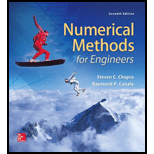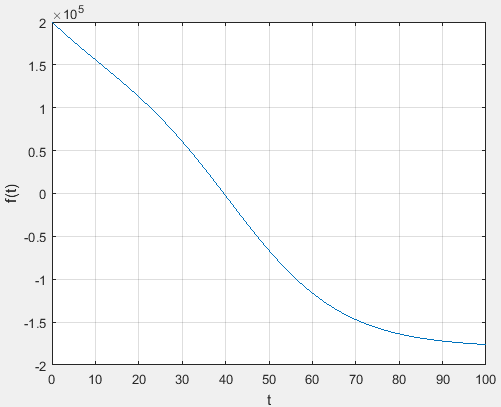
Concept explainers
Many fields of engineering require accurate population estimates. For example, transportation engineers might find it necessary to determine separately the population growth trends of a city and adjacent suburb. The population of the urban area is declining with time according to
while the suburban population is growing, as in
where
(a)
To calculate: The values of the urban and sub-urban population and the corresponding time where the urban population is given by the formula
Answer to Problem 23P
Solution: After 40 years, the suburban population would be 1.2 times the urban population with the populations of the suburban and urban areas being 137482 and 112487, respectively.
Explanation of Solution
Given Information:
The expression,
for the parameters
Calculation:
Substitute 75000 for
Substitute 300000 for
It has been provided that at time t, the suburban population is 20% larger than the urban population, that is, 1.2 times the urban population. Thus, from equation (1) and equation (2),
This equation can be rewritten in the form of a following function whose zero corresponds with the root of the equation,
The desired value of t can be found by plotting the function f with respect to t and then computing the value at which the function crosses the x-axis.
Use the following MATLAB code to plot the function
Execute the above code to obtain the plot as,

From the graph, the curve crosses horizontal axis through the origin at approximately
Substitute 40 for t in the formula for the urban population to get,
Hence, the urban population after 40 years is 112397.
Substitute 40 for t in the formula for the suburban population to get,
Hence, the suburban population after 40 years is 137482.
(b)
To calculate: The values of the urban and sub-urban population and the time where the urban population is given by the formula
Answer to Problem 23P
Solution: After 39.6068 years, the suburban population would be 1.2 times the urban population with the populations of the suburban and urban areas being 13 5142.5 and 112 618.7, respectively.
Explanation of Solution
Given Information:
The expressions,
Formula used:
An equation
Step 1- Compute
Step 2- If
Step 3- Proceed with the same procedure till
Calculation:
Substitute 75000 for
Substitute 300000 for
It has been provided that at time t, the suburban population is 20% larger than the urban population or 1.2 times the urban population. Thus,
The above equation can be rewritten in the form of a following function whose zero corresponds with the root of the equation,
The desired value of t can be found using the false position method.
Let the initial interval be
Then,
As
Now proceed with the first iteration as follows,
Further,
As
Now proceed with the second iteration as follows,
The relative approximate percentage error is,
Continue with the same process till the relative approximate percentage error is less that 0.1%.
Use the following MATLAB code to implement false-position method and solve for the roots iteratively as,
Execute the above code to obtain the solutions tabulated as,
The process is stopped at the fifth iteration where the relative approximate percentage error is less than 0.1%. This gives the value of t as 39.6068 years.
Substitute 39.6068 for t in the formula for the urban population to get,
Hence, the urban population after 39.6068 years is
Substitute 39.6068 for t in the formula for the suburban population to get,
Hence, the suburban population after 39.6068 years is
(c)
To calculate: The values of the urban and sub-urban population and the time where the urban population is given by the formula
Answer to Problem 23P
Solution: After 39.6068 years, the suburban population would be 1.2 times the urban population with the populations of the suburban and urban areas being 13 5142.5 and 112 618.7, respectively.
Explanation of Solution
Given Information:
The expression,
Formula used:
An equation
Step 1: Let
Step 2: Compute
Step 3: Proceed with the same process till
Calculation:
Substitute 75000 for
Substitute 300000 for
It has been provided that at time t, the suburban population is 20% larger than the urban population, that is, 1.2 times the urban population. Thus,
The above equation can be rewritten in the form of a following function whose zero corresponds with the root of the equation.
The desired value of t can be found using the modified secant method.
Let the initial guess be 50 and the value of h be 0.01.
Then,
And,
Now proceed with the first iteration as follows:
Further,
And,
Now proceed with the second iteration as follows:
The relative approximate percentage error is,
Continue with the same process till the relative approximate percentage error is less that 0.1%.
Use the following MATLAB code to implement modified secant method and solve for the roots iteratively as,
Execute the above code to obtain the solutions tabulated as,
The process is stopped at the third iteration where the relative approximate percentage error is less that 0.1%. This gives the value of t as 39.6068 years.
Substitute 39.6068 for t in the formula for the urban population to get,
Hence, the urban population after 39.6068 years is
Substitute 39.6068 for t in the formula for the suburban population to get:
Hence, the suburban population after 39.6068 years is
Want to see more full solutions like this?
Chapter 8 Solutions
Numerical Methods for Engineers
Additional Math Textbook Solutions
Advanced Engineering Mathematics
Fundamentals of Differential Equations (9th Edition)
Basic Technical Mathematics
Statistics for Psychology
Calculus for Business, Economics, Life Sciences, and Social Sciences (13th Edition)
- Algebra & Trigonometry with Analytic GeometryAlgebraISBN:9781133382119Author:SwokowskiPublisher:Cengage
 Linear Algebra: A Modern IntroductionAlgebraISBN:9781285463247Author:David PoolePublisher:Cengage Learning
Linear Algebra: A Modern IntroductionAlgebraISBN:9781285463247Author:David PoolePublisher:Cengage Learning Algebra and Trigonometry (MindTap Course List)AlgebraISBN:9781305071742Author:James Stewart, Lothar Redlin, Saleem WatsonPublisher:Cengage Learning
Algebra and Trigonometry (MindTap Course List)AlgebraISBN:9781305071742Author:James Stewart, Lothar Redlin, Saleem WatsonPublisher:Cengage Learning


